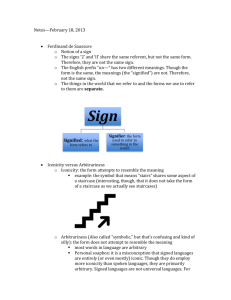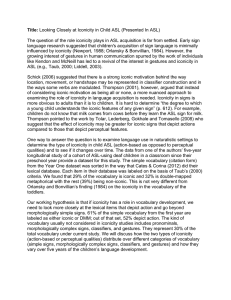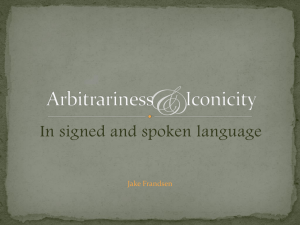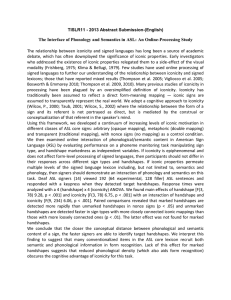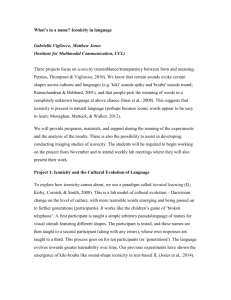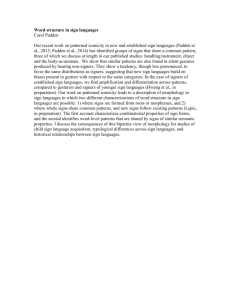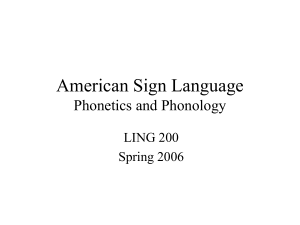Does iconicity help children learn language? Evidence from deaf and... To be presented in ASL
advertisement
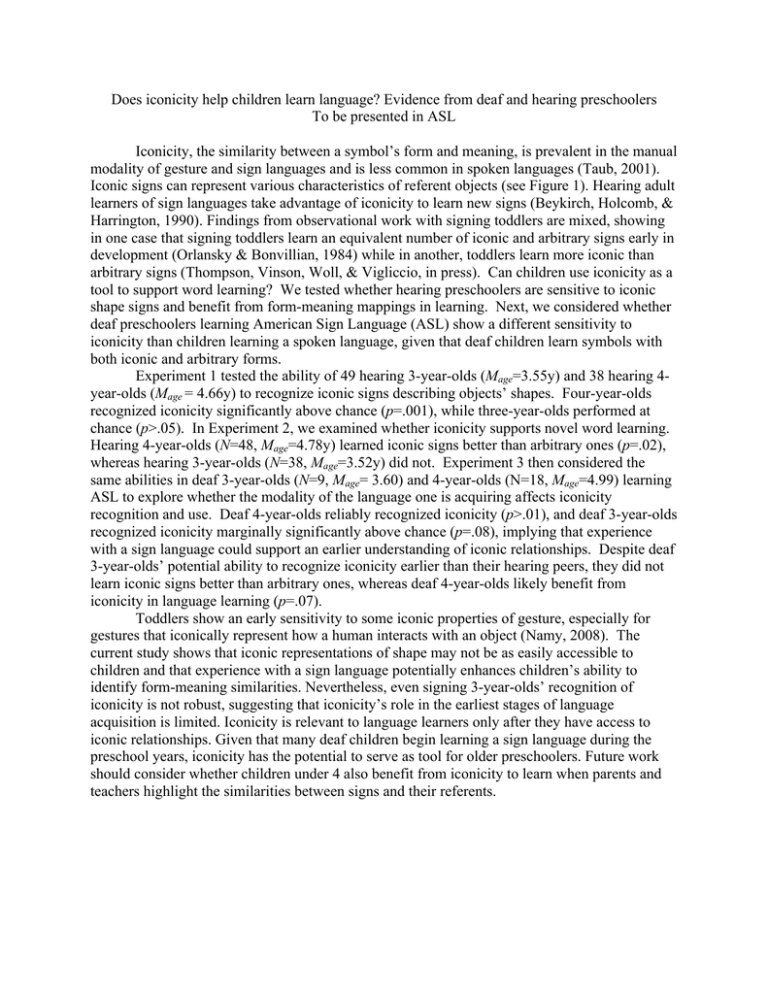
Does iconicity help children learn language? Evidence from deaf and hearing preschoolers To be presented in ASL Iconicity, the similarity between a symbol’s form and meaning, is prevalent in the manual modality of gesture and sign languages and is less common in spoken languages (Taub, 2001). Iconic signs can represent various characteristics of referent objects (see Figure 1). Hearing adult learners of sign languages take advantage of iconicity to learn new signs (Beykirch, Holcomb, & Harrington, 1990). Findings from observational work with signing toddlers are mixed, showing in one case that signing toddlers learn an equivalent number of iconic and arbitrary signs early in development (Orlansky & Bonvillian, 1984) while in another, toddlers learn more iconic than arbitrary signs (Thompson, Vinson, Woll, & Vigliccio, in press). Can children use iconicity as a tool to support word learning? We tested whether hearing preschoolers are sensitive to iconic shape signs and benefit from form-meaning mappings in learning. Next, we considered whether deaf preschoolers learning American Sign Language (ASL) show a different sensitivity to iconicity than children learning a spoken language, given that deaf children learn symbols with both iconic and arbitrary forms. Experiment 1 tested the ability of 49 hearing 3-year-olds (Mage=3.55y) and 38 hearing 4year-olds (Mage = 4.66y) to recognize iconic signs describing objects’ shapes. Four-year-olds recognized iconicity significantly above chance (p=.001), while three-year-olds performed at chance (p>.05). In Experiment 2, we examined whether iconicity supports novel word learning. Hearing 4-year-olds (N=48, Mage=4.78y) learned iconic signs better than arbitrary ones (p=.02), whereas hearing 3-year-olds (N=38, Mage=3.52y) did not. Experiment 3 then considered the same abilities in deaf 3-year-olds (N=9, Mage= 3.60) and 4-year-olds (N=18, Mage=4.99) learning ASL to explore whether the modality of the language one is acquiring affects iconicity recognition and use. Deaf 4-year-olds reliably recognized iconicity (p>.01), and deaf 3-year-olds recognized iconicity marginally significantly above chance (p=.08), implying that experience with a sign language could support an earlier understanding of iconic relationships. Despite deaf 3-year-olds’ potential ability to recognize iconicity earlier than their hearing peers, they did not learn iconic signs better than arbitrary ones, whereas deaf 4-year-olds likely benefit from iconicity in language learning (p=.07). Toddlers show an early sensitivity to some iconic properties of gesture, especially for gestures that iconically represent how a human interacts with an object (Namy, 2008). The current study shows that iconic representations of shape may not be as easily accessible to children and that experience with a sign language potentially enhances children’s ability to identify form-meaning similarities. Nevertheless, even signing 3-year-olds’ recognition of iconicity is not robust, suggesting that iconicity’s role in the earliest stages of language acquisition is limited. Iconicity is relevant to language learners only after they have access to iconic relationships. Given that many deaf children begin learning a sign language during the preschool years, iconicity has the potential to serve as tool for older preschoolers. Future work should consider whether children under 4 also benefit from iconicity to learn when parents and teachers highlight the similarities between signs and their referents. References Beykirch, H.L., Holcomb, T.A., & Harrington, J.F. (1990). Iconicity and sign vocabulary acquisition. American Annals of the Deaf, 135, 306-311. Namy, L. L. (2008). Recognition of iconicity doesn’t come for free. Developmental Science, 11, 841-846. Orlansky, M. D., & Bonvillian, J. D. (1984). The role of iconicity in early sign language acquisition. Journal of Speech & Hearing Disorders, 49, 287-292. Taub, S. F. (2001). Language from the body: Iconicity and metaphor in American Sign Language. New York, NY: Cambridge University Press. Thompson, Vinson, Woll, & Vigliocco (in press). The road to language learning is iconic: Evidence from British Sign Language. Psychological Science. Figure 1. Images showing (A) the ASL handing iconic sign HAMMER mimics how one holds the object; (B) the ASL shape iconic sign HOUSE traces the outline of a prototypical house; and (C) the ASL iconic sign CAT depicts a part of the object’s shape.

